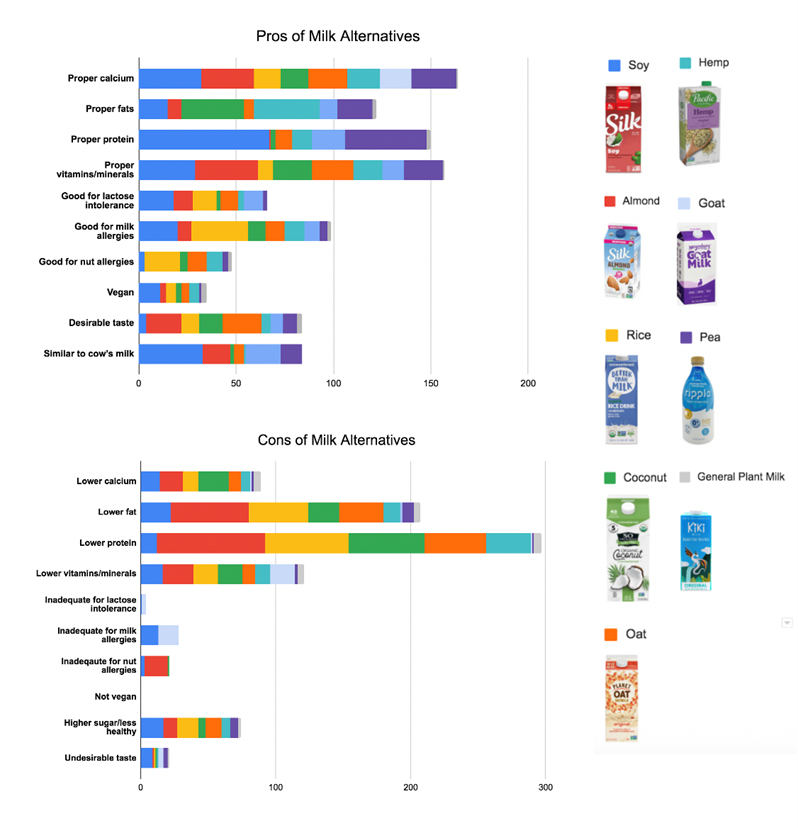



Parents of toddlers get facts about nut milks & dairy substitutes from nonmedical influencers
In a study of most Influential bloggers writing about milks substitutes in the US, about half have no medical credentialsParents of young children under age 5, interested in alternatives to dairy milk, like nut and rice milks, are finding information online, and almost half of the most popular bloggers on this topic were neither dieticians or medical professionals, according to research presented during the 2023 American Academy of Pediatrics (AAP) National Conference & Exhibition.
Researchers of the abstract, “Milk Mania: Analyzing Online Information and Perception regarding Milk Alternatives for Toddlers,” studied the 145 most popular blogs for parents of children under age 5 on the topic of milk alternatives. They found that while many parents are seeking information online on the topic of alternatives for milk, 47% of the most popular bloggers on this topic were laypersons without medical training. Of the other bloggers, 32% were nutritionists or dieticians, 12% physicians or nurses, 5% holistic providers, and 4% PhDs and scientists.
“The large number of online blogs discussing dairy milk alternatives for toddlers suggests that this is an issue of great interest to caregivers, who may turn to blogs that provide unsupported information and nutritional recommendations about milk substitutes,” said lead author Kara Sangiuolo, a medical student at Albert Einstein College of Medicine. “I think that there is a major opportunity for pediatricians and pediatric nutritionists to enter the online space and provide more accurate, consistent information to support caregivers looking to transition their toddlers away from dairy milk.”
Of the popular blogs studied, bloggers were most likely to recommend soy milk (37%) and pea milk (17%) as the best milk alternatives, and the most common alternatives referenced were soy milk (84%), almond milk (79%), and rice milk (65%) coconut (60%), oat (54%), hemp (43%), goat (37%), pea (35%), general plant-based milk (11%), and other milks (i.e., homemade, potato) (28%) (Figure 1). However, 14 blogs recommended making homemade milks for toddlers, and two blogs claimed homemade milk as the best milk alternative (i.e., “homemade [is] always better than store bought”; “make a more nutritious, fuller bodied and flavored milk”).
Figure 1. Characteristics of Various Types of Milk Alternatives Across Blogs

“Several blogs included unsupported recommendations such as making unfortified homemade milks for growing toddlers. The lack of consistent information across blogs was concerning, and only half of all blogs discussed the nutrient compositions of dairy milk alternatives,” Sangiuolo said. “This reveals the need for greater dissemination of accurate nutritional recommendations regarding dairy milk alternatives from pediatricians and nutritionists. This information can be delivered online to reach caregivers and better promote the healthy development and nutrition of toddlers in early childhood.”
Concerns for switching to milk alternatives included:
- growth/development issues (27%)
- nutritional value (75%)
- taste (21%).
83% of blogs mentioned allergies/intolerances (i.e., dairy, nut, soy, gluten); 54% described milk alternative nutrient compositions. Of blogs discussing soy milk, 29% mentioned risk of isoflavones/phytoestrogens; 23% of blogs discussing rice milk mentioned risk of arsenic.
Common positive comments regarding milk alternatives included:
- proper calcium content (n=164),
- proper vitamins/minerals (n=157);
Negative comments included:
- lower protein content (n=297)
- lower fat content (n=207)
Online blogs provide a large source of information for caregivers seeking to switch their toddlers from dairy milk to milk alternatives. While a portion of blogs were authored by medical professionals, nearly half were written by laypeople lacking the proper training necessary to counsel others regarding milk alternatives or pediatric nutrition. Additionally, unsupported recommendations such as making unfortified homemade milks presents significant concern for growing toddlers.
It is imperative that pediatricians and nutritionists have a greater online presence in order to guide milk alternatives-related recommendations and ensure the healthy development and nutrition of toddlers in early childhood.
Table 1. Pros/Cons and Best Claimed Milk Alternatives across Blogs

This research was supported by Cohen Children’s Medical Center in the Division of Developmental and Behavioral Pediatrics and with the support of Dr. Andrew Adesman and Dr. Charles Schleien.



